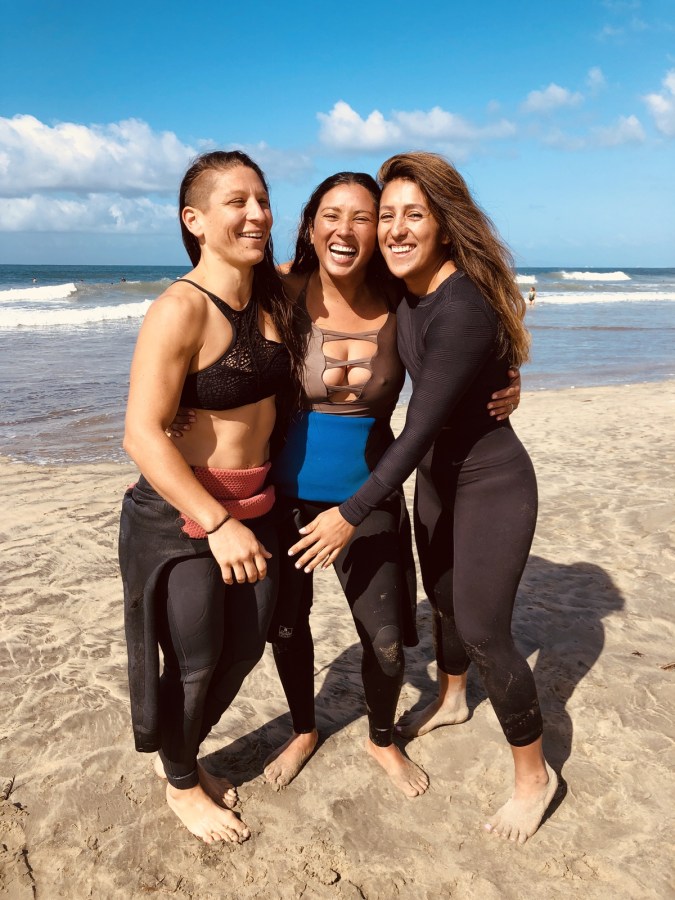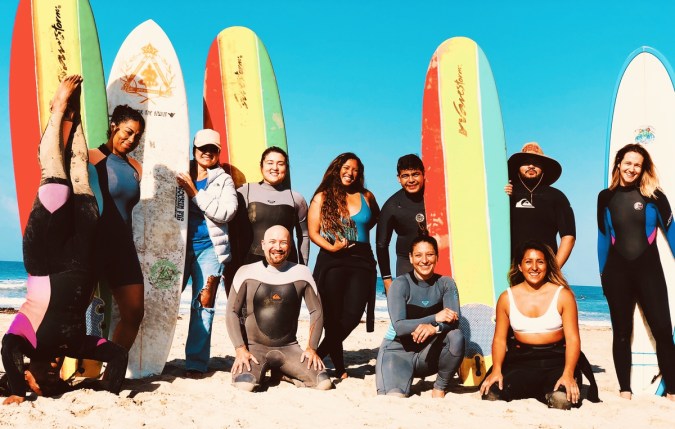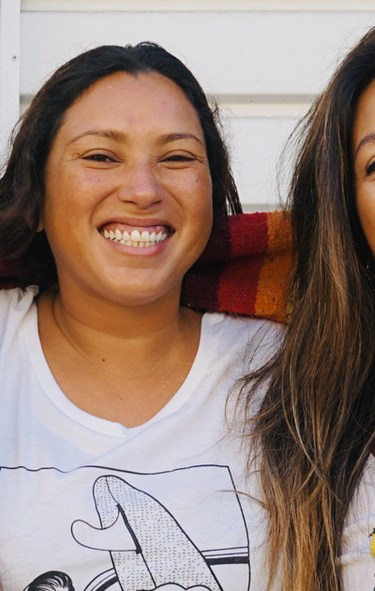Surfing is widely seen as a white man’s sport, but three Latinas with roots in East Los Angeles are combating this stereotype with a surfing camp for people of color.
For more than two years, surfers Giselle Carrillo, Vanessa Yeager and Cassie Comley, Ph.D., have been filling a void they see in surfing — the underrepresentation of Latinos in the sport — with Courage Camps, a community founded on November 25, 2017 to teach people of color in LA and Orange County how to surf and create a space for rookies and veterans alike to bond and socialize.
“We welcome all people of any color and culture. It has become a beautiful melting pot bonding in the ocean,” Carrillo tells Remezcla.
“It has become a beautiful melting pot bonding in the ocean.”
While surfing is a major sport in California, many Latina surfers find it difficult to meet other women with similar interests and cultural backgrounds. In search of community, Carrillo found Yeager on Instagram while skimming through surfer tags. From there, the two struck up a friendship, regularly surfing together in Newport Beach in Orange County.
At the time, Comley was working on a doctoral dissertation about Mexican-American surfers. Through her research, she discovered Yeager and Carrillo, and the three ultimately bonded over their shared love of the sport.
“I decided to study Mex-Am surfers because there’s a real gap in the literature examining Mexican Americans’ experiences in sporting spaces,” the academic tells Remezcla. “Historically, dominant sporting narratives focused on white male sporting experiences, but recently there’s been a shift in the field to capture more diverse voices.”
Growing up, Comley, who is Mexican American, says she did not see many Latino surfers, or people of color in general, like herself in the sport. The same is true for Carrillo, but that changed for the surfer when she visited Playa Sayulita, a popular surf spot in Nayarit, Mexico. Surrounded by Mexican surfers, she began to realize how big the sport was in the country and, soon, across Latin America. Suddenly, she started to feel represented in a sport she initially perceived as not for brown or Black people.
According to Thrillism, some of the best surf towns are in Latin America and include cities like San Juan Del Sur, Nicaragua; Sayulita, Mexico; Tamarindo, Costa Rica; Nuquí, Colombia; Santa Catarina, Brazil and La Paloma, Uruguay. However, in California, the sport remains predominantly white.

The same is true in pop culture, with Michelle Rodriguez’s role in the 2002 sports drama film Blue Crush still the most recognizable Latina surfer character nearly two decades later. Through the camp, the women hope to widen the portrayal of Latinas in the sport for the generations behind them.
“My hope for Courage Camps is that we end mental poverty that little girls and boys from my community face, the idea that certain things are impossible for them,” Carrillo says. “Because when you look at it, surfing seems kind of impossible for a little brown girl or boy from East LA. No one you know surfs, the beach is far away and you might not even know how to swim.”
In California in particular, the state’s most famous surf spots are commonly recognized as the terrain of white men. According to Peter Westwick, surfer and author of The World in the Curl: An Unconventional History of Surfing, the overwhelming whiteness of the sport is rooted in the country’s not-so-distant history of racial segregation.
“Surfing seems kind of impossible for a little brown girl or boy from East LA.”
In an interview with the University of Southern California’s Trojan Family, Westwick explains that public pools in California were once divided by race, with African Americans relegated to “Jim Crow pools” that were poorly maintained. Because there were fewer options for Black Americans, Westwick says they were less likely to learn how to swim, an issue that has carried over into contemporary times with white people today still twice as likely to know how to swim than African Americans.
Additionally, Westwick argues that beach towns in California have historically been expensive and thus inaccessible to impoverished communities of color. For instance, in Orange County, a region in the Los Angeles Metropolitan Area that has 40 miles of coastline suitable for surfing, the population is 71.5 percent white.
“The history of swimming in America is a very interesting and complicated one that helps explain racial segregation in surfing,” Westwick told the institution.
That’s why all three women convene at Newport Beach to host Courage Camps, providing free surfing lessons along with no-cost wetsuits and surfboards for interested participants who don’t have the means to purchase their own gear. Last year, they started a GoFundMe page to help raise money for four foam surfboards and 20 wetsuits. For the women, it’s most important that they provide a welcoming space to learn how to surf.

“There was a lack of community for Latin surfers, so we thought: let’s create one. That way we can bring people together and pass on the good vibes,” Yeager, a Puerto Rican and Mexican surfer who is the group’s primary instructor, says.
One of these community members is Amé Tamu Flournoy, who at the age of 48 found the opportunity to learn a sport she had always been interested in.
“My teen years were spent in the OC, so most of the people I saw surfing were white males. I didn’t see brown girls like me surfing at all. I always wanted to try, but didn’t have the opportunity at that time,” Flournoy tells Remezcla. “Camp Courage is giving that opportunity to people of all ages, but it’s the early exposure to young brown girls that I find so important and that I must get behind as a woman of Native, Mexican and Black heritage.”
“It will be the most heartbreaking and beautiful journey of your life.”
The same is true for 34-year-old Salvadoran Alfonso Moreno, who joined the camp with his 9-year-old son.
“One of the key takeaways for me from Courage Camps was learning that sports have no boundaries and it doesn’t matter what race, nationality, gender or skin color you have,” Moreno tells Remezcla. “I wanted to get involved because it seemed like a challenge, and I knew my son Josiah would love it. I also decided to get involved because I wanted to do things with my son that I wished my dad would have done with me.”
For Carrillo, Yeager and Comley, these are the confidence-building, identity-affirming and life-changing experiences they hoped Courage Camps would offer its participants, personal transformations and memories that are bigger than surf lessons. It’s about achieving what feels like the impossible for brown and Black people and carving out a space for people of color in a community that didn’t seem accessible or hospitable in the past.
“It will be the most heartbreaking and beautiful journey of your life because, especially for Latinas, we are taught that there is so much we are ‘not supposed to do’ or ‘should not do.’ No one ever encourages us to try the impossible, to try to prove our history and culture wrong, to be different, to be strong, to be courageous,” Carillo says. “Picking up a board and teaching yourself how to no longer fear but rather love the ocean will teach you how to do the same in all other parts of your life.”




